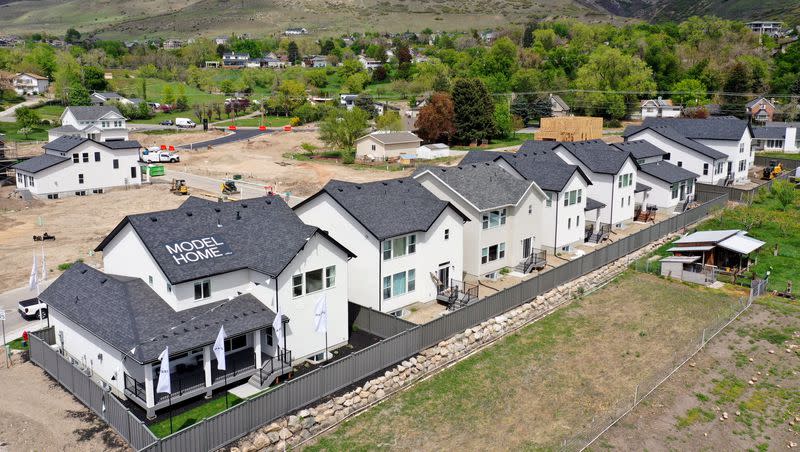Housing affordability is now worse than before 2006 bubble popped. Where does Utah stand?

With mortgage rates hitting their highest level in over 20 years, along with stubbornly sticky prices, U.S. housing market affordability is even lower than at the peak of the housing bubble in 2006.
That’s according to the Federal Reserve Bank of Atlanta, which scored its Home Ownership Affordability Monitor a low 69.5 in June, with a national median home price of $372,825, median income of $76,072, interest rate of 6.7%, and total median monthly payment of $2,737, including taxes and insurance. The Atlanta Fed estimated the annual total payment share of median income to be more than 43%, well over the recommended 30% of income.
Compare that score to a score of 112.3 in November 2012, when the median home price was $197,333, median income was $52,161, and the interest rate was 3.4%.
Since June, rates have only risen, putting even more pressure on affordability. The average 30-year fixed mortgage rate hit 7.48% this week, marking the highest level since 2000, according to Mortgage News Daily.
U.S. housing affordability is at its lowest point in decades, even worse than before the 2006 bubble, according to @AtlantaFed https://t.co/zZWrxQMIQg pic.twitter.com/Ho0FZq1bYV
— Katie McKellar (@KatieMcKellar1) August 24, 2023
Related
“The housing market is at a pivotal point as we head into fall. Mortgage rates are now at more than a two-decade high, and for some home shoppers, those higher rates are enough to cause them to step back from the market,” Lisa Sturtevant, chief economist at Bright MLS, told Fortune this week. “It is likely to be a very slow fall (in the) housing market this year. Home prices, which had rebounded this summer, will dip in some markets as new listing activity increases at the same time a segment of the homebuying population sits the market out.”
Sturtevant said she doesn’t expect “major (house) price corrections since supply is still at historically low levels and overall economic conditions remain healthy,” but she does see risk in pandemic hot spot areas like Austin and Boise, where house prices have seen more dramatic price corrections amid spiked interest rates.
Idaho and Utah, both states where housing demand exploded during the pandemic, are among states with the nation’s largest year-over-year home price declines in 2023, though since this winter Utah’s housing prices have been on a slow upward trajectory.
Related
Is the housing market crashing?
Even though affordability levels are worse than before the 2006 housing bubble popped, sending the economy tumbling into the Great Recession, housing experts and economists have continued to say today’s housing market doesn’t face the same risks — and they don’t expect the real estate market to come crashing down, though prices are correcting slightly in areas such as the West.
That’s because the U.S. as a whole — and especially rapidly growing areas like Utah — faces a yearslong housing shortage. Before the 2008 crash, the nation had a surplus of homes for sale, driven in part by synthetic demand fueled by risky lending practices that led to a subprime mortgage crisis. Today, experts say the market is not fraught with the same risky lending practices, and housing demand is real due to population growth and household formation.
Related
In 2022, the U.S. saw a housing shortage of 6.5 million homes, as demonstrated by the gap between single-family home construction and household formations, according to a March Realtor.com report.
In Utah, the pandemic housing rush brought a surge of homebuyers and a homebuilding boom in 2021. That made a dent on the state’s housing shortage by bringing it from an estimated shortage of 56,000 units in 2017 to 31,000 in 2022, according to housing researchers at the University of Utah’s Kem C. Gardner Policy Institute. But since then, home building and sales have constricted as the market has cooled, which could in turn worsen Utah’s housing shortage.
Related
How does Utah’s housing affordability compare?
In June of last year — when Utah’s housing prices peaked — an estimated 70% of Utah households were priced out of affording the state’s median priced home. But that was when mortgage rates were closer to 5%. Now, though prices are slightly lower, the over 7% interest rate has kept monthly payments high and likely out of reach for as many if not even more Utahns.
Salt Lake City ranks among the nation’s least affordable metro areas, according to the Atlanta Fed’s Metro Area Home Ownership Affordability Monitor Index. Salt Lake City was given a score of 65 (anything below 100 is considered unaffordable), with a median income of $88,193, a median home price of $495,582, an interest rate of 6.7%, and a total median monthly payment of $3,394, including taxes and insurance.
Here's how SLC, Utah compares, according to the @AtlantaFed's Metro Area Home Ownership Affordability Monitor (HOAM) Index https://t.co/zZWrxQMb0I pic.twitter.com/nojNR4n9uy
— Katie McKellar (@KatieMcKellar1) August 24, 2023
Related

